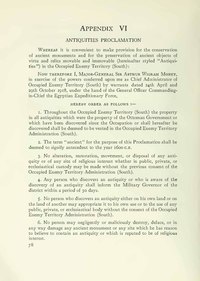Operation

In December 1918, while Palestine was still under control of a British military administration, a Proclamation for the protection of antiquities was issued. [1] [2] In July 1920, the military administration was replaced by a civil administration under High Commissioner Herbert Samuel. One of the first actions of the new government was to establish a Department of Antiquities and promulgate an Antiquities Ordinance that defined its functions and authority. [3] The Ordinance was designed to follow principles outlined in the abortive Treaty of Sèvres, which were later included as Article 21 in the Mandate for Palestine. [4] The main features of the Ordinance were:
- An "antiquity" was defined as any product of human activity before 1700 AD, though there was an exception for objects actively used for religious purposes.
- Authority from the department was required for the disposal or export of an antiquity.
- Permission from the department was required for excavations, and would only be given to "learned societies or institutions or to individuals of proved scientific competence guaranteed by such bodies".
- Proceeds from artefact discovery would be shared by the discoverer and the department in a proportion determined by the department, after objects needed for the "scientific completeness of the Palestine Museum" were chosen.
- The department had the power to expropriate or forcibly lease private property containing important artefacts if no satisfactory agreement with the owners could be reached. [4] [2]
The Ordinance was replaced in 1929 and amended in 1934 and 1946. [2]
As well as a Director, the department had an Archaeological Advisory Board that included representatives of the major archaeological bodies and the main ethnic communities in Palestine. [4] [5] The department included subdivisions for inspectors, a records office and library, a conservation laboratory, a photographic studio, and the museum. [6]
The department was located in a building called "Way House", north of the Old City of Jerusalem. [7] The British School of Archaeology in Jerusalem, established in 1919, also occupied the building until 1930. [7] The Palestine Archaeological Museum, which was managed by the department, was also in Way House until 1935, when it moved with the department to a new building in east Jerusalem donated by John D. Rockefeller. [7] The museum reopened to the public in 1938 and is now popularly known as the Rockefeller Museum. [7]